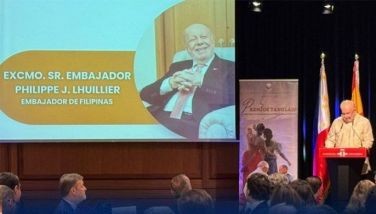Costly delay

April 13, 2005 | 12:00am
When does a compromise agreement of cases pending in court become binding between parties, upon the signing thereof by the parties or upon approval by the Court?
EVS was the plaintiff in five civil cases filed against SVHFI pending before the Regional Trial Court (RTC). He was also the appellant in two cases pending in the Court of Appeals. By virtue of these cases, various notices of lis pendens were annotated on SVHFI’s real properties.
On October 26, 1990, EVS and SVHFI signed a Compromise Agreement (CA) where it was agreed that immediately upon the signing and initial payment of P1.5 million out of a total consideration of P14.5 million EVS would cause the dismissal of all cases and the immediate lifting of the notices of lis pendens. The parties likewise agreed that the balance of P13 million shall be paid by SVHFI within a period of not more than 2 years from the execution of the agreement whether in one lump sum or installment at the discretion of SVHFI.
In compliance with this CA, EVS moved for the dismissal of all the civil cases and the lifting of the notices of lis pendens while SVHFI paid him the P1.5 million leaving a balance of P13 million. Subsequently and with the balance still unpaid, SVHFI sold two real properties which were previously subjects of the lis pendens. When EVS discovered said sale, he demanded payment of the remaining balance. But EVS ignored said demand even as the CA was approved by the RTC on September 30, 1991.
When the two years lapsed without SVHFI paying the balance of P13 million, EVS sent another letter inquiring when it would pay. But there was no response from SVHFI. So EVS applied for the issuance of a writ of execution of the CA, which was granted by the RTC. Thereafter, on March 10, 1993, the Sheriff levied on the real properties of SVHFI which were formerly subjects of the lis pendens. But the said properties could not be auctioned as SVHFI still tried to block the enforcement of the writ by filing numerous motions and other legal challenges that even reached the Supreme Court although to no avail. Finally on November 22, 1994 and February 8, 1995, the real properties of SVHFI located in Pampanga and Bacolod were auctioned off with RVI as the highest bidder for a total of P13 million.
Since SVHFI still had the right to redeem the properties within one year, EVS and RVI the highest bidder filed a complaint for Declaratory Relief to determine the amount of the redemption price. They alleged that there was delay in paying said balance since the obligation became due on October 26, 1992 or two years after the signing of the CA on October 26, 1990 whereas EVS got fully paid only on February 8, 1995. So the principal amount of P13 million should still earn legal rate of interest from the due date and the same must be added to the redemption price. SVHFI however countered that the delay was only due to its valid exercise of its rights to protect its interests as provided in the Rules especially because as far as it was concerned the two-year period started to run only when the CA was approved by the RTC on September 30, 1991. Was SVHFI correct?
No. A compromise agreement has upon the parties the effect and authority of res judicata or a judicial decision on the matter definitely stated therein, or which by implication from its terms should be deemed to have been included therein, from the time it was entered into even if it has not been judicially approved. In the case at bar, the CA was entered into on October 26, 1990. So as a consensual contract, it became binding between the parties on such date which was the date of its execution and not upon its court approval on September 30, 1991. The two-year period must be counted from October 26, 1990, and not from its judicial approval on September 30, 1991. When EVS wrote the demand letter to SVHFI on October 28, 1992, the two-year period had already elapsed and the obligation was already due and demandable so that when SVHFI failed to pay its obligation after that demand was made, it incurred delay. SVHFI already knew how much he was to pay and when he should pay it but it was fully settled only on February 08, 1995 which was more than two years after the extrajudicial demand because SVHFI still filed several motions and elevated adverse resolutions to the appellate court to hinder the execution of a final judgment and further delay the fulfillment of its obligation.
When the debtor knows the amount and period when he is to pay, interest as damages is generally allowed as a matter of right. So SVHFI should pay EVS and RVI: (1) legal interest on the principal amount of P13 million at the rate of 12 % per annum from October 28, 1992 up to the date of actual payment of the whole obligation; and (2) P20,000 attorney’s fees (Santos etc. Foundation, Inc. vs. Santos et. al. G.R. 153004, November 5, 2004).
E-mail: [email protected]
EVS was the plaintiff in five civil cases filed against SVHFI pending before the Regional Trial Court (RTC). He was also the appellant in two cases pending in the Court of Appeals. By virtue of these cases, various notices of lis pendens were annotated on SVHFI’s real properties.
On October 26, 1990, EVS and SVHFI signed a Compromise Agreement (CA) where it was agreed that immediately upon the signing and initial payment of P1.5 million out of a total consideration of P14.5 million EVS would cause the dismissal of all cases and the immediate lifting of the notices of lis pendens. The parties likewise agreed that the balance of P13 million shall be paid by SVHFI within a period of not more than 2 years from the execution of the agreement whether in one lump sum or installment at the discretion of SVHFI.
In compliance with this CA, EVS moved for the dismissal of all the civil cases and the lifting of the notices of lis pendens while SVHFI paid him the P1.5 million leaving a balance of P13 million. Subsequently and with the balance still unpaid, SVHFI sold two real properties which were previously subjects of the lis pendens. When EVS discovered said sale, he demanded payment of the remaining balance. But EVS ignored said demand even as the CA was approved by the RTC on September 30, 1991.
When the two years lapsed without SVHFI paying the balance of P13 million, EVS sent another letter inquiring when it would pay. But there was no response from SVHFI. So EVS applied for the issuance of a writ of execution of the CA, which was granted by the RTC. Thereafter, on March 10, 1993, the Sheriff levied on the real properties of SVHFI which were formerly subjects of the lis pendens. But the said properties could not be auctioned as SVHFI still tried to block the enforcement of the writ by filing numerous motions and other legal challenges that even reached the Supreme Court although to no avail. Finally on November 22, 1994 and February 8, 1995, the real properties of SVHFI located in Pampanga and Bacolod were auctioned off with RVI as the highest bidder for a total of P13 million.
Since SVHFI still had the right to redeem the properties within one year, EVS and RVI the highest bidder filed a complaint for Declaratory Relief to determine the amount of the redemption price. They alleged that there was delay in paying said balance since the obligation became due on October 26, 1992 or two years after the signing of the CA on October 26, 1990 whereas EVS got fully paid only on February 8, 1995. So the principal amount of P13 million should still earn legal rate of interest from the due date and the same must be added to the redemption price. SVHFI however countered that the delay was only due to its valid exercise of its rights to protect its interests as provided in the Rules especially because as far as it was concerned the two-year period started to run only when the CA was approved by the RTC on September 30, 1991. Was SVHFI correct?
No. A compromise agreement has upon the parties the effect and authority of res judicata or a judicial decision on the matter definitely stated therein, or which by implication from its terms should be deemed to have been included therein, from the time it was entered into even if it has not been judicially approved. In the case at bar, the CA was entered into on October 26, 1990. So as a consensual contract, it became binding between the parties on such date which was the date of its execution and not upon its court approval on September 30, 1991. The two-year period must be counted from October 26, 1990, and not from its judicial approval on September 30, 1991. When EVS wrote the demand letter to SVHFI on October 28, 1992, the two-year period had already elapsed and the obligation was already due and demandable so that when SVHFI failed to pay its obligation after that demand was made, it incurred delay. SVHFI already knew how much he was to pay and when he should pay it but it was fully settled only on February 08, 1995 which was more than two years after the extrajudicial demand because SVHFI still filed several motions and elevated adverse resolutions to the appellate court to hinder the execution of a final judgment and further delay the fulfillment of its obligation.
When the debtor knows the amount and period when he is to pay, interest as damages is generally allowed as a matter of right. So SVHFI should pay EVS and RVI: (1) legal interest on the principal amount of P13 million at the rate of 12 % per annum from October 28, 1992 up to the date of actual payment of the whole obligation; and (2) P20,000 attorney’s fees (Santos etc. Foundation, Inc. vs. Santos et. al. G.R. 153004, November 5, 2004).
BrandSpace Articles
<
>
- Latest
- Trending
Trending
Latest
Trending
Latest
Recommended




























